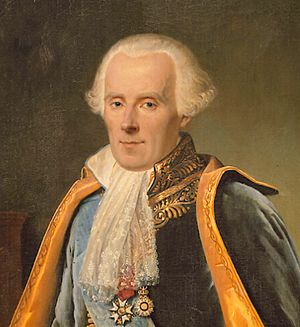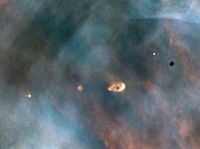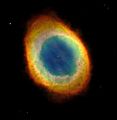Formation and evolution of the Solar System facts for kids
The formation and evolution of the Solar System explains how our Sun, planets, and everything else in our cosmic neighborhood came to be. It also describes how these things will keep changing over time. Scientists believe that about 4.6 billion years ago, a giant cloud of gas and dust, called a nebula, existed in our part of space.
All things with mass (which means they have "stuff" in them) pull towards each other because of gravity. This force pulled all the gas and dust in the nebula towards its center. As more and more material gathered, the pressure and temperature at the center became extremely high. Eventually, hydrogen atoms started to join together (this is called nuclear fusion) to make helium. This process released a huge amount of energy and lit up the star we now call the Sun. The way solar systems are created from these clouds is known as the nebular theory.
The original gas cloud wasn't perfectly smooth; it had different amounts of stuff in different places. This caused it to start spinning. As the cloud pulled together because of gravity, it spun even faster and flattened out, like a spinning pizza dough. This fast spin kept some of the gas from falling directly into the center. Instead, it spread out into a flat, spinning disk around the young Sun. The planets later formed from this disk.
The Sun is incredibly massive, holding about 99.86% of all the mass in our Solar System! This gives it a very strong gravity. The planets orbit the Sun because the pull of the Sun's gravity is balanced by the force of the planets moving in a circle. Inside the Sun's core, the intense pressure causes fusion reactions that turn hydrogen into helium. This process releases heat, light, and other types of electromagnetic radiation that warm and light up our world.
The rocky planets like Earth, their moons, asteroids, and other objects in the Solar System are made of rock and dust. Even the gas giant planets (like Jupiter and Saturn) are thought to have rocky or metallic centers. Scientists know this from information gathered by spacecraft. This rocky material couldn't have come from the Sun, because the Sun is mostly hydrogen and helium.
So, if the Sun only makes helium from hydrogen, where did all the other elements (like carbon, oxygen, and iron) come from? The answer is that these heavier elements were created inside much older, bigger stars. Billions of years ago, before our Solar System formed, these huge stars exploded in events called supernovas. These explosions scattered the heavier elements into space, which then became part of the nebula that formed our Sun and planets. Giant stars live much shorter lives than smaller stars like our Sun because of the even higher pressures and temperatures inside them.
How Scientists Figured It Out


The idea of the nebular hypothesis, which explains how stars and planets form from gas clouds, was first developed in the 1700s. Three important thinkers contributed to this idea:
- Emanuel Swedenborg (1688–1772)
- Immanuel Kant (1724–1804)
- Pierre-Simon Laplace (1749–1827)
Swedenborg first had the basic concept. Then, Immanuel Kant developed it into a more complete theory. In 1755, Kant published his book Universal Natural History and Theory of the Heavens. He suggested that gas clouds, called nebulae, slowly spin, then gradually shrink and flatten out because of gravity. Over time, these clouds would form stars and planets.
Around the same time, Pierre-Simon Laplace came up with a similar model independently in 1796. He thought the Sun originally had a huge, hot atmosphere that filled the space where our Solar System is now. As this early Sun cooled and shrank, it would have flattened and spun faster. This spinning would cause it to throw off rings of gas. According to Laplace, the planets then formed from these rings of material. His model was similar to Kant's but more detailed.
However, there was a problem with Laplace's idea. It couldn't explain why the planets have almost all of the Solar System's spinning energy (called angular momentum), while the Sun has very little. It took a long time for scientists to understand this puzzle.
The modern and widely accepted theory of how planets form is called the solar nebular disk model (SNDM). A Soviet astronomer named Victor Safronov greatly advanced this theory. His book, translated into English in 1972, had a big impact. In it, he laid out many of the main challenges in understanding planet formation and even solved some of them. Safronov's ideas have been further developed by scientists since then. There are still some things about the Solar System that scientists are working to explain.
Even though this model was first used to explain our own Solar System, scientists now believe that the SNDM describes the usual way star formation happens throughout the universe. As of August 2017, scientists have found over 3,000 extrasolar planets (planets outside our Solar System) in our galaxy. This suggests that planet formation is a very common process.
Images for kids
-
Meteor Crater in Arizona. Created 50,000 years ago by an impactor about 50 metres (160 ft) across, it shows that the accretion of the Solar System is not over.
-
Artist's idea of the giant impact thought to have formed the Moon
-
Neptune and its moon Triton, taken by Voyager 2. Triton's orbit will eventually take it within Neptune's Roche limit, tearing it apart and possibly forming a new ring system.
See also
 In Spanish: Formación y evolución del sistema solar para niños
In Spanish: Formación y evolución del sistema solar para niños






